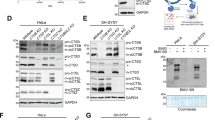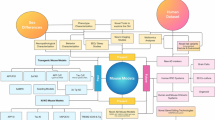Abstract
More than 20 human diseases are associated with protein misfolding, which results in the appearance of amyloids, fibrillar aggregates of normally soluble proteins. Such diseases are termed amyloid diseases, or amyloidoses. Of these, only prion diseases are transmissible. Amyloids of the prion type are known for lower eukaryotes. While mammalian prions cause neurodegenerative diseases, prions of lower eukaryotes are associated with some nonchromosomally inherited phenotypic traits. The review summarizes the results of studying the prions of yeast Saccharomyces cerevisiae and data obtained using S. cerevisiae as a model to investigate some human amyloidoses such as Alzheimer’s, Parkinson’s, Huntington’s, and prion diseases.
Similar content being viewed by others
References
Prusiner S.B., Scott M.R., DeArmond S.J., Cohen F.E. 1998. Prion protein biology. Cell. 93, 337–348.
Ter-Avanesyan M.D., Paushkin S.V., Kushnirov V.V., Kochneva-Pervukhova N.V. 1998. Molecular mechanisms of “protein” heredity: Yeast prions. Mol. Biol. 32, 36–46.
Uptain S.M., Lindquist S. 2002. Prions as protein-based genetic elements. Annu. Rev. Microbiol. 56, 703–741.
Derkatch I.L., Bradley M.E., Hong J.Y., Liebman S.W. 2001. Prions affect the appearance of other prions: The story of [PIN +]. Cell. 106, 171–182.
Osherovich L.Z., Weissman J.S. 2001. Multiple Gln/Asn-rich prion domains confer susceptibility to induction of the yeast [PSI +] prion. Cell. 106, 183–194.
Salnikova A.B., Kryndushkin D.S., Smirnov V.N., et al. 2005. Nonsense suppression in yeast cells overproducing Sup35 (eRF3) is caused by its non-heritable amyloids. J. Biol. Chem. 280, 8808–8812.
King C.Y., Diaz-Avalos R. 2004. Protein-only transmission of three yeast prion strains. Nature. 428, 319–323.
Tanaka M., Chien P., Naber N., et al. 2004. Conformational variations in an infectious protein determine prion strain differences. Nature. 428, 323–328.
Brachmann A., Baxa U., Wickner R.B. 2005. Prion generation in vitro: Amyloid of Ure2p is infectious. EMBO J. 24, 3082–3092.
Kryndushkin D.S., Alexandrov I.M., Ter-Avanesyan M.D., Kushnirov V.V. 2003. Yeast [PSI +] prion aggregates are formed by small Sup35 polymers fragmented by Hsp104. J. Biol. Chem. 278, 49636–49643.
Bagriantsev S.N., Liebman S.W. 2004. Specificity of prion assembly in vivo: [PSI +] and [PIN +] form separate structures in yeast. J. Biol. Chem. 279, 51042–51048.
Jones G.W., Tuite M.F. 2005. Chaperoning prions: The cellular machinery for propagating an infectious protein? Bioessays. 27, 823–832.
Kushnirov V.V., Ter-Avanesyan M.D. 1998. Structure and replication of yeast prions. Cell. 94, 13–16.
Ness F., Ferreira P., Cox B.S., Tuite M.F. 2002 Guanidine hydrochloride inhibits the generation of prion “seeds” but not prion protein aggregation in yeast. Mol. Cell. Biol. 22, 5593–5605.
Ma J., Lindquist S. 1999. De novo generation of a PrPSc-like conformation in living cells. Nature Cell Biol. 1, 358–361.
Bach S., Talarek N., Andrieu T., et al. 2003. Isolation of drugs active against mammalian prions using a yeast-based screening assay. Nature Biotechnol. 21, 1075–1081.
Coughlan C.M., Brodsky J.L. 2005. Use of yeast as a model system to investigate protein conformational diseases. Mol. Biotechnol. 30, 171–180.
Koo E.H., Squazzo S.L. 1994. Evidence that production and release of amyloid β-protein involves the endocytic pathway. J. Biol. Chem. 269, 17386–17389.
Xu H., Sweeney D., Wang R., et al. Generation of Alzheimer β-amyloid protein in the trans-Golgi network in the apparent absence of vesicle formation. Proc. Natl. Acad. Sci. USA. 94, 3748–3752.
Skovronsky D.M., Pijak D.S., Doms R.W., Lee V.M. 2000. A distinct ER/IC γ-secretase competes with the proteasome for cleavage of APP. Biochemistry. 39, 810–817.
Cook D.G., Forman M.S., Sung J.C., et al. 1997. Alzheimer’s Aβ1-42 is generated in the endoplasmic reticulum/intermediate compartment of NT2N cells. Nature Medicine. 3, 1021–1023.
Zhang W., Espinoza D., Hines V., et al. 1997. Characterization of β-amyloid peptide precursor processing by the yeast Yap3 and Mkc7 proteases. Biochim. Biophys. Acta. 1359, 110–122.
Komano H., Seeger M., Gandy S., et al. 1998. Involvement of cell surface glycosyl-phosphatidylinositol-linked aspartyl proteases in α-secretase-type cleavage and ectodomain solubilization of human Alzheimer β-amyloid precursor protein in yeast. J. Biol. Chem. 273, 31648–31651.
Luthi U., Schaerer-Brodbeck C., Tanner S., et al. 2003. Human β-secretase activity in yeast detected by a novel cellular growth selection system. Biochim. Biophys. Acta. 1620, 167–178.
Middendorp O., Ortler C., Neumann U., et al. 2004. Yeast growth selection system for the identification of cell-active inhibitors of β-secretase. Biochim. Biophys. Acta. 1674, 29–39.
Edbauer D., Winkler E., Regula J.T., et al. 2003. Reconstitution of γ-secretase activity. Nature Cell Biol. 5, 486–488.
Le Brocque D., Henry A., Cappai R., et al. 1998. Processing of the Alzheimer’s disease amyloid precursor protein in Pichia pastoris: Immunodetection of α-, β-, and γ-secretase products. Biochemistry. 37, 14958–14965.
Tsaponina O.E., Lada A.G., Rubel’ A.A., et al. 2005. Analysis of effects of Aβ-Sup35MC hybrid protein production in yeast Saccaromyces cerevisiae. Ekol. Genet. 3, 24–32.
Leroy E., Boyer R., Auburger G. 1998. The ubiquitin pathway in Parkinson’s disease. Nature. 395, 451–452.
Lucking C.B., Brice A. 2000. α-Synuclein and Parkinson’s disease. Cell Mol. Life Sci. 57, 1894–1908.
Outeiro T.F., Lindquist S. 2003. Yeast cells provide insight into α-synuclein biology and pathobiology. Science. 302, 1771–1775.
Dixon C., Mathias N., Zweig R.M., et al. 2005. α-Synuclein targets the plasma membrane via the secretory pathway and induces toxicity in yeast. Genetics. 170, 47–59.
Brandis K.A., Holmes I.F., England S.J. 2006. α-Synuclein fission yeast model: Concentration-dependent aggregation without plasma membrane localization or toxicity. J. Mol. Neurosci. 28, 179–191.
Zabrocki P., Pellens K., Vanhelmont T., et al. 2005. Characterization of α-synuclein aggregation and synergistic toxicity with protein tau in yeast. FEBS J. 272, 1386–1400.
Flower T.R., Chesnokova L.S., Froelich C.A., et al. 2005. Heat shock prevents α-synuclein-induced apoptosis in a yeast model of Parkinson’s disease. J. Mol. Biol. 351, 1081–1100.
Jenco J., Rawlingson A., Daniels B., Morris A. 1998. Regulation of phospholipase D2: selective inhibition of mammalian phospholipase D isoenzymes by α-and β-synucleins. Biochemistry. 37, 4901–4909.
de Silva H.A.R., Khan N.L., Wood N.W. 2000. The genetics of Parkinson’s disease. Curr. Opin. Genet. Dev. 3, 292–298.
Griffioen G., Duhamel H., van Damme N., et al. 2006. A yeast-based model of α-synucleinopathy identifies compounds with therapeutic potential. Biochim. Biophys. Acta. 1762, 312–318.
Landles C., Bates G. 2004. Huntingtin and the molecular pathogenesis of Huntington’s disease. Fourth in molecular medicine review series. EMBO Rep. 5, 958–963.
Harjes P., Wanker E.E. 2003. The hunt for huntingtin function: Interaction partners tell many different stories. Trends Biochem. Sci. 28, 425–433.
Krobitsch S., Lindquist S. 2000. Aggregation of huntingtin in yeast varies with the length of the polyglutamine expansion and the expression of chaperone proteins. Proc. Natl. Acad. Sci. USA. 97, 1589–1594.
Kimura Y., Koitabashi S., Kakizuka A., Fujita T. 2001. Initial process of polyglutamine aggregate formation in vivo. Genes Cells. 6, 887–897.
Kimura Y., Koitabashi S., Kakizuka A., Fujita T. 2002. Circumvention of chaperone requirement for aggregate formation of a short polyglutamine tract by the coexpression of a long polyglutamine tract. J. Biol. Chem. 277, 37536–37541.
Muchowski P.J., Schaffar G., Sittler A., et al. 2000. Hsp70 and hsp40 chaperones can inhibit self-assembly of polyglutamine proteins into amyloid-like fibrils. Proc. Natl. Acad. Sci. USA. 97, 7841–7846.
Meriin A.B., Zhang X., He X., et al. 2002. Huntingtin toxicity in yeast model depends on polyglutamine aggregation mediated by a prion-like protein Rnq1. J. Cell Biol. 157, 997–1004.
Meriin A.B., Zhang X., Miliaras N.B., et al. 2003. Aggregation of expanded polyglutamine domain in yeast leads to defects in endocytosis. Mol. Cell. Biol. 23, 7554–7565.
Kimura Y., Koitabashi S., Kakizuka A., Fujita T. 2004. The role of pre-existing aggregates in Hsp104-dependent polyglutamine aggregate formation and epigenetic change of yeast prions. Genes Cells. 9, 685–696.
Derkatch I.L., Uptain S.M., Outeiro T.F., et al. 2004. Effects of Q/N-rich, polyQ, and non-polyQ amyloids on the de novo formation of the [PSI +] prion in yeast and aggregation of Sup35 in vitro. Proc. Natl. Acad. Sci. USA. 101, 12934–12939.
Duennwald M.L., Jagadish S., Giorgini F., et al. 2006. A network of protein interactions determines polyglutamine toxicity. Proc. Natl. Acad. Sci. USA. 103, 11051–11056.
Willingham S., Outeiro T.F., DeVit M.J., et al. 2003. Yeast genes that enhance the toxicity of a mutant huntingtin fragment or α-synuclein. Science. 2, 1769–1772
Giorgini F., Guidetti P., Nguyen Q., et al. 2005. A genomic screen in yeast implicates kynurenine 3-monooxygenase as a therapeutic target for Huntington disease. Nature Genet. 37, 526–531.
Hu Y., Liu L., Kmiec E.B. 2003. Reduction of Htt inclusion formation in strains of Saccharomyces cerevisiae deficient in certain DNA repair functions: A statistical analysis of phenotype. Exp. Cell. Res. 291, 46–55.
Hughes R.E., Lo R.S., Davis C., et al. 2001. Altered transcription in yeast expressing expanded polyglutamine. Proc. Natl. Acad. Sci. USA. 98, 13201–13206.
Colby D.W., Chu Y., Cassady J.P., et al. 2004. Potent inhibition of huntingtin aggregation and cytotoxicity by a disulfide bond-free single-domain intracellular antibody. Proc. Natl. Acad. Sci. USA. 101, 17616–17621.
Author information
Authors and Affiliations
Additional information
Original Russian Text © A.B. Vishnevskaya, V.V. Kushnirov, M.D. Ter-Avanesyan, 2007, published in Molekulyarnaya Biologiya, 2007, Vol. 41, No. 2, pp. 346–354.
Rights and permissions
About this article
Cite this article
Vishnevskaya, A.B., Kushnirov, V.V. & Ter-Avanesyan, M.D. Neurodegenerative amyloidoses: Yeast model. Mol Biol 41, 308–315 (2007). https://doi.org/10.1134/S0026893307020112
Received:
Accepted:
Issue Date:
DOI: https://doi.org/10.1134/S0026893307020112




